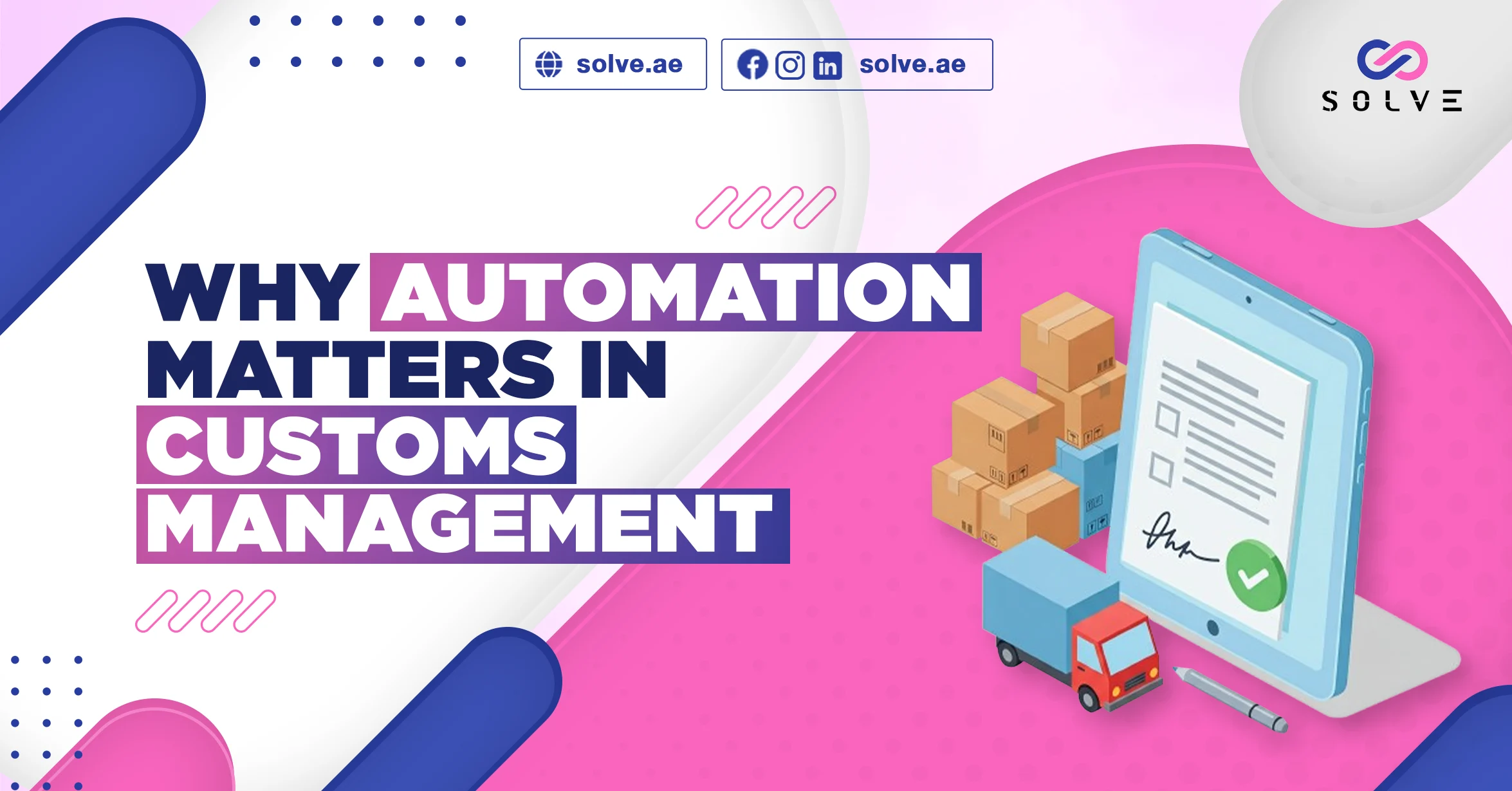- By Vanshika Choudhary
- April 11, 2025
Automating customs management is changing the face of international trade for businesses by making it faster, more accurate, and cost-effective. When one starts seeing regulations getting stiffer and global competition going higher, he knows that automation is not an option but a necessity for anyone in international markets. It is about optimizing the process, reducing errors, and ensuring that everyone complies with the ever-changing framework. Automation in customs gives the business better operational efficiency while going the extra mile on the balance sheet. Additionally, automation enables organizations to fine-tune their systems to adapt easily to changes in global trade, which is vital for sustaining a competitive advantage.
An Introduction to Customs Management Challenges
Customs management usually involves moving goods from and to one’s country, and these have a lot of intricacies. There is the handling of the various legislations in different countries that would comply with duty structures and documentation. Manual processes in customs management are most likely to cause errors, be inefficient, and take too long to cause disruption in a supply chain, leading to loss. Some of the factors recently affecting Europe and its sanctions on Russia are bringing new layers of complexity to customs environments. The need for a supply chain and processing efficiency to live by has grown due to sanctions disrupting global supply chains. Automation comes in handy as the answer to streamlining these processes and ensuring compliance and flexibility.
The Major Advantages of Automation in Customs Management
- Enhanced Productivity
With manual processes such as data entry and document review out of the way, automation is able to quicken processing times significantly. Automated systems can sift through data at massive, lightning speeds, ensuring that product clearances are quick, thereby reducing storage costs that could accrue during the waiting period. For example, RPA processes customs declarations at a pace never before thought possible outside a purely human pace, ensuring the delivery of goods on time. Such efficiency allows organizations to carry bigger loads of trade with no corresponding increase in staff, saving resources. The even workflow pattern is hence maintained even at peak times or in cases of reduced manpower.
- Enhanced accuracy
Manual data entry always contains errors that could cause trouble with compliance or shipment delays. Validation checks at declaration and standardization tools will help minimize errors in customs declarations. Machine learning algorithms will ensure high accuracy levels in regulatory compliance by cross-checking trade documents for any discrepancies. It further reduces the amounts that can be incurred in fines or penalties related to inappropriate filings. In addition, automated systems can update their templates and corresponding rules automatically by the demands of recent regulatory modifications to guarantee real-time compliance with current regulations. This prevents more than a fair share of ‘costly’ mistakes and keeps an organization out of messy compliance penalties.
- Cost Savings
By optimizing operational flows and reducing labor inputs, automation provides huge financial gains. Companies save money on operational costs while circumventing penalties associated with non-compliance or delays in shipment. Moreover, cost-saving opportunities arise through automation from, for example, Special Procedures (e.g., Inward Processing), which grant relief from import duties and VAT. Such savings could be funneled back into strategic endeavors or to improve customer service. In addition, automation makes extensive training programs for human workers superfluous since automated systems can easily adapt to handle complex regulatory demands.
- Scalability
An automated system is built with ease to manage fluctuating trade volumes. As businesses increase operations on a global scale, automation will allow for scalability without compromising efficiency or accuracy. This flexibility is crucial for the management of seasonal peaks or unanticipated bursts in transaction volumes. Automated systems can be integrated with the current infrastructure without much effort, allowing companies to upscale or downscale at their will. Also, scalability will allow strategic growth initiatives by ensuring customs operations keep in tandem with increasing trade volumes.
- Regulatory Compliance
The international trade regulations keep changing all the time. The dynamic nature of the automated system allows flexibility to update templates and rules that ensure businesses remain compliant all the time with the latest regulatory changes. The automated risk assessment tool also detects possible concerns at the earliest stages before they escalate into costly problems. This preventive resolution of compliance management reduces the incidence of facing fines or taking up costly legal options. Also, the automation brings the suppliers and logistics partners in line with the latest regulations. This is very important for ensuring a compliant supply chain.
- Data Visibility and Analytics
Automation offers real-time access to trade data and analytics for better decision-making. Companies use such intelligence to steer optimizations in supply chains, recognize tendencies, and improve performance metrics. The effect of enhancing visibility across stakeholders is also witnessed in share data security with the use of blockchain technology. This visibility is essential in identifying bottlenecks and improvement areas for a business to refine its strategies based on these insights. Additional insights through analytics can indicate potential interruptions so that timely action may be taken to avert risks.
Technological Innovations Fueling Automation
Machine Learning and Artificial Intelligence
AI has the capacity to read documents, extract the necessary information in a customs declaration, and trace the discrepancies in trade procedures. This reduces manual processes while also ensuring that operations are accurate and efficient. On top of that, certain decision-making procedures, such as the most cost-effective shipping routes or even the optimum customs procedure, would be automated. This allows fast and precise strategic decision-making for the firm.
Robotic Process Automation
Robotic Process Automation automates repetitive activities such as document generation and data validation. This ensures that routine activities are all performed with consistency while freeing up human resources to do strategic activities. Robotic process automation also integrates with complementary existing systems to make its implementation seamless without disruption of the existing workflows. This is because it automates tedious work tasks done by humans, thereby reducing the possibility of human error and increasing productivity. Besides, RPA runs 24/7 and is thus in position to give continuous customs operations support.
Blockchain Technology
Blockchain is an e-sharing and secure platform for exchanging information among stakeholders involved in the customs process. This has ensured transparency along with data integrity in global supply chains. Shipment tracking through real-time usage of Blockchain will have everyone in the process tracking the status of goods.
Digital Platforms
Enabling a digital link to the open platforms is important for freight forwarding, suppliers, and customs authorities for their seamless collaboration. Those platforms would automate the processing of documents and compliance checks in order to truly simplify workflows. Digital platforms enable real-time communication that facilitates the prompt resolution of issues that sometimes crop up during the customs process.
Challenges of Automation Across Customs Management
The major disadvantages that automation brings with it include:
- Initial Investment Costs
Automated systems involve high initial investments in technology infrastructure and software development. Small enterprises may find it a burden to incur such costs at first. However, automated systems save much money in the long run while improving efficiency and thus justify the initial investment. Therefore, businesses need to consider phased implementation processes in order to manage costs. Most automation solutions also provide scalable pricing models, keeping growing businesses in mind. Check out our latest blog post on what is e-commerce how to build your online business with e-commerce
- Customization Needs
It may become complex to customize automation systems to a particular industry or regulatory framework. The custom may have specialized requirements for its implementation and could add to the cost and time. The important point for businesses is to ensure that this close communication with technology providers for automated systems is suitable enough to cover all the specific requirements of businesses. This is the real-time for the customer to maximize the benefits from automation without unwarranted disruptions in the existing flows. In addition, customization is also important for the seamless integration of automated systems with existing infrastructure.
- Over-Dependence Risks
In reality, overdependence tends to be less flexible when it comes to dealing with abnormal and unintended events. The adoption of hybrid automation, which allows for humans without intervention, would empower resource establishments with that requisite future-proof component expected from automation and, at the same time, be able to offer flexibility when dealing with unforeseen hurdles. Human intervention ensures that automated systems operate within the scope defined by business strategies and rapid adaptability to local market requirements.
Finding That Perfect Place: Combination of Hybrid
The hybrid scheme mixing automation and human processes gives the best return:
Simple and routine tasks, like data processing, can be done automatically.
The human operator intervenes in cases of judgment or more complex personalized services.
Flexibility is maintained through both streams.
For example, Descartes Customs Management Software enables you to build templates for repetitive tasks but allows human intervention to use them for unique client requirements or regulatory nuances. This balance between automation and human expertise guarantees efficiency while ensuring flexibility in the customs operations of organizations. This equilibrium is essential for managing complex trade scenarios and the unknown challenges of not having public limitations.
Given here will be the future trends in customs automation:
The future of customs will rely heavily on progressive technologies that improve efficiency further:
AI will use predictive analytics to predict trade trends.
The greatest cause of transparency in world supply chains will be this uptown blockchain.
Integration with devices related to the Internet of Things (IoT) will offer real-time tracking of shipments.
It will provide a cloud-based platform for collaborative engagement of stakeholders from nations around the world.
With all these features, future custom management systems are open to increasing streamlining and greater resilience. Furthermore, as technologies evolve, businesses must spend their time keeping track of their advancements to be competitive. Investment in the latest automation solutions will be important for tackling challenges as well as opportunities the future holds for global trading.
Conclusion
Automation revolutionizes customs management by addressing inefficiencies, decreasing errors, and ensuring compliance with regulations. It gains a competitive advantage through reduced costs, scalability, and superior operational performance for those businesses that implement the technology. However, the issue of full automation is not easy. Contact us as It involves planning and facing challenges such as initial costs and the need for customization. A hybrid mix of automation with human input entails flexibility while deriving the maximum benefits.
Investment in state-of-the-art automation technology becomes imperative for businesses if they are to continue thriving in a world that is becoming increasingly interconnected. To leverage their application for the future in maximizing the benefits of automation without foregoing the human element, which may provide flexibility, thus giving organizations a clear advantage over their competitors, automating the entire process is undertaken with serious planning.




